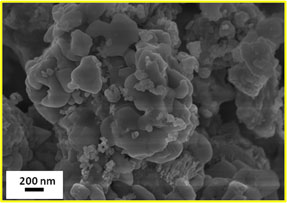Crossref Citations
This article has been cited by the following publications. This list is generated based on data provided by
Crossref.
Isık, Tuğba
Elhousseini Hilal, Mohamed
and
Horzum, Nesrin
2019.
Zinc Oxide Based Nano Materials and Devices.
Muthuvel, A.
Jothibas, M.
and
Manoharan, C.
2020.
Effect of chemically synthesis compared to biosynthesized ZnO-NPs using Solanum nigrum leaf extract and their photocatalytic, antibacterial and in-vitro antioxidant activity.
Journal of Environmental Chemical Engineering,
Vol. 8,
Issue. 2,
p.
103705.
Obeizi, Zahra
Benbouzid, Houneida
Ouchenane, Sihem
Yılmaz, Deniz
Culha, Mustafa
and
Bououdina, Mohamed
2020.
Biosynthesis of Zinc oxide nanoparticles from essential oil of Eucalyptus globulus with antimicrobial and anti-biofilm activities.
Materials Today Communications,
Vol. 25,
Issue. ,
p.
101553.
Alamdari, Sanaz
Sasani Ghamsari, Morteza
Lee, Chan
Han, Wooje
Park, Hyung-Ho
Tafreshi, Majid Jafar
Afarideh, Hosein
and
Ara, Mohammad Hosein Majles
2020.
Preparation and Characterization of Zinc Oxide Nanoparticles Using Leaf Extract of Sambucus ebulus.
Applied Sciences,
Vol. 10,
Issue. 10,
p.
3620.
Bhatti, Muhammad Ali
Tahira, Aneela
Chandio, Ali dad
Almani, Khalida Faryal
Bhatti, Adeel Liaquat
Waryani, Baradi
Nafady, Ayman
and
Ibupoto, Zafar Hussain
2021.
Enzymes and phytochemicals from neem extract robustly tuned the photocatalytic activity of ZnO for the degradation of malachite green (MG) in aqueous media.
Research on Chemical Intermediates,
Vol. 47,
Issue. 4,
p.
1581.
Velázquez-Herrera, Franchescoli Didier
Lobo-Sánchez, Marta
and
Fetter, Geolar
2021.
Effect of copper and eucalyptol on the bactericidal activity of ZnAl- and MgAl-LDH clays.
MRS Communications,
Vol. 11,
Issue. 6,
p.
955.
Ashraf, Aniqa
Liu, Guijian
Yousaf, Balal
Arif, Muhammad
Ahmed, Rafay
Rashid, Audil
Riaz, Luqman
and
Rashid, Muhammad Saqib
2022.
Phyto-mediated photocatalysis: a critical review of in-depth base to reactive radical generation for erythromycin degradation.
Environmental Science and Pollution Research,
Vol. 29,
Issue. 22,
p.
32513.
Mutukwa, Dorcas
Taziwa, Raymond
and
Khotseng, Lindiwe
2022.
Antibacterial and Photodegradation of Organic Dyes Using Lamiaceae-Mediated ZnO Nanoparticles: A Review.
Nanomaterials,
Vol. 12,
Issue. 24,
p.
4469.
Albarakaty, Fawziah M.
Alzaban, Mayasar I.
Alharbi, Nada K.
Bagrwan, Fatima S.
Abd El-Aziz, Abeer R.M.
and
Mahmoud, Mohamed A.
2023.
Zinc oxide Nanoparticles, Biosynthesis, characterization and their potent photocatalytic degradation, and antioxidant activities.
Journal of King Saud University - Science,
Vol. 35,
Issue. 1,
p.
102434.
El Golli, A.
Contreras, S.
and
Dridi, C.
2023.
Bio-synthesized ZnO nanoparticles and sunlight-driven photocatalysis for environmentally-friendly and sustainable route of synthetic petroleum refinery wastewater treatment.
Scientific Reports,
Vol. 13,
Issue. 1,
Hussaini, Ali Akbar
Tugay, Osman
Mirza, Sudenaz
Ulukuş, Deniz
Durmaz, Fatih
and
Yıldırım, Murat
2023.
Photosensing performances of the green synthesized ZnO micro/nanorods using different parts of the Lupinus pilosus: a comparative study.
Journal of Materials Science: Materials in Electronics,
Vol. 34,
Issue. 29,
Bashir, Iqra
Dilshad, Erum
and
Šiler, Branislav T.
2024.
A comparative study of Mentha longifolia var. asiatica and Zygophyllum arabicum ZnO nanoparticles against breast cancer targeting Rab22A gene.
PLOS ONE,
Vol. 19,
Issue. 8,
p.
e0308982.
Shubha, J.P.
Roopashree, B.
Sushma, N.V.
Kiran, K.
Ravikumar, R.
Kuniyil, Mufsir
Rafi Shaik, Mohammed
Khan, Mujeeb
and
Farooq Adil, Syed
2024.
Photocatalytic and eco-emission applications of green synthesized ZnO-CB nanoparticles.
Journal of King Saud University - Science,
Vol. 36,
Issue. 9,
p.
103373.
Mallick, Suhasini
Nag, Moupriya
Bhattacharya, Debasmita
Tandi, Antara
Chakraborty, Buddhadeb
Rao, Anjali
Dutta, Bandita
and
Ray, Rina Rani
2024.
Green-synthesized ZnO nanorods as potential deefeblement agent of Pseudomonas aeruginosa and Staphylococcus aureus biofilm.
Biocatalysis and Agricultural Biotechnology,
Vol. 57,
Issue. ,
p.
103091.
Yadav, Annu
Jangid, Nirmala Kumari
and
Khan, Azhar U.
2024.
Biogenic synthesis of ZnO nanoparticles from Evolvulus alsinoides plant extract.
Journal of Umm Al-Qura University for Applied Sciences,
Vol. 10,
Issue. 1,
p.
51.
Droepenu, Eric Kwabena
Amenyogbe, Eric
Boatemaa, Mercy Adusei
and
Opoku, Evelyn
2024.
Study of the antimicrobial activity of zinc oxide nanostructures mediated by two morphological structures of leaf extracts of Eucalyptus robusta Sm.
Heliyon,
Vol. 10,
Issue. 4,
p.
e25590.
Akhtar, Seemab
Adnan, Muhammad
Sharif, Saima
and
Khan, Saeed Ahmad
2025.
Modulation Response of Biologically Synthesized ZnO Nanoparticles Using Mentha piperita L. on the Physio‐Chemical Parameters of Pisum sativum L..
Journal of Plant Nutrition and Soil Science,
Vol. 188,
Issue. 1,
p.
151.
Dhiman, Sakshi
Kumari, Asha
Kumari, Shilpa
and
Sharma, Rahul
2025.
Advanced biodegradable starch-based nanocomposite films incorporating zinc oxide nanoparticles: Synthesis, characterization, and efficacy in antibacterial food packaging applications.
Journal of Environmental Chemical Engineering,
Vol. 13,
Issue. 3,
p.
116296.
